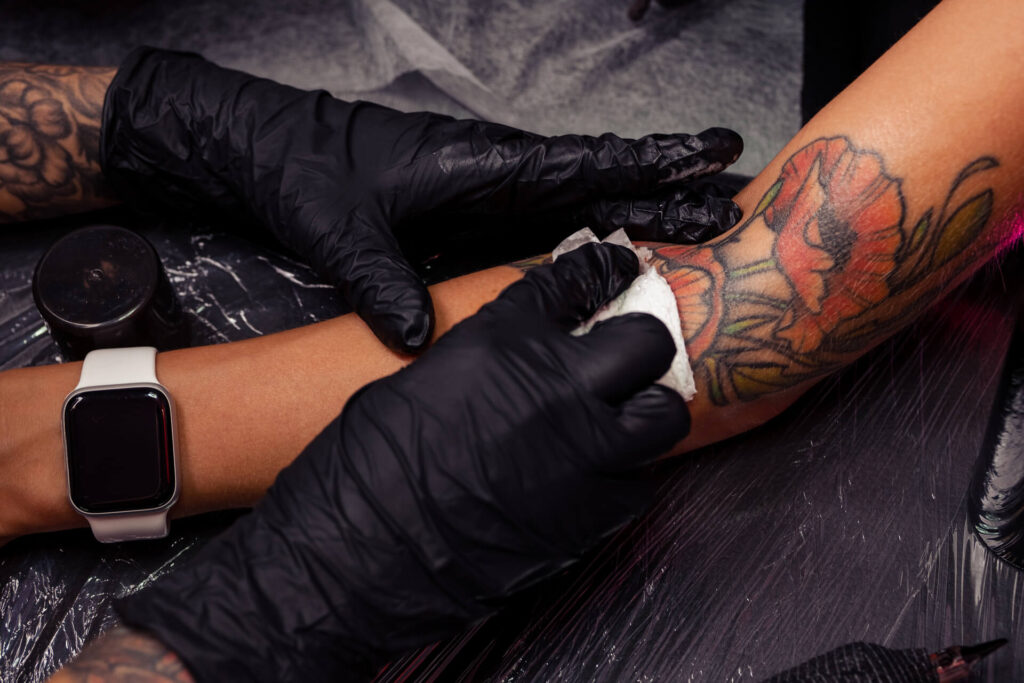
You knew getting a tattoo would come with some aftercare, but something feels… off. Is that redness normal? Why is it still throbbing after a week? If your instincts are screaming that your ink isn’t healing right, don’t ignore them! This guide breaks down the red flags you should never brush off—plus exactly what to do if you spot them. Whether you’re a first-timer or a tattoo veteran, knowing these warning signs could save your ink (and your skin) from disaster.
Red Flag #1: Extreme and Persistent Redness and Swelling
It’s completely fine for a fresh tattoo to be red, tender, and slightly swollen for the first couple of days—much like a mild sunburn. However, if the redness intensifies instead of fading after Day 3, spreads beyond the tattooed area, or feels unusually hot to the touch, your body might be signaling an issue. Excessive swelling that makes movement difficult, especially when felt on arm or leg tattoos, is another red flag.
What To Do: Start by applying a clean, cold compress (wrapped in a paper towel) for short 10-minute intervals to reduce inflammation. If the tattoo is on a limb, try keeping it elevated when possible. But if the swelling and redness continue to worsen or are accompanied by pulsing pain, don’t wait—reach out to a healthcare professional. An untreated infection can damage both your skin and your tattoo.
Red Flag #2: Oozing That Isn’t Just Plasma
In the first 48 hours, it’s normal for a new tattoo to weep a little clear or pale yellow fluid (plasma). This is part of your skin’s natural healing response. But if you notice thick, cloudy, greenish, or foul-smelling discharge after the first few days, that’s a major warning sign of infection. Pus, especially when combined with increasing pain, means it’s time to take action.
What To Do: Gently wash the area with lukewarm water and a mild, fragrance-free soap to remove any buildup. Avoid slathering on ointment, as too much moisture can trap bacteria. Let the tattoo air-dry and keep an eye on it. If the oozing persists or looks like pus, skip the home remedies and see a doctor ASAP. Antibiotics may be necessary to clear an infection before it causes lasting damage.
Red Flag #3: Scabbing That Won’t Stop (Or Looks “Crusty”)
A healing tattoo will naturally form some thin, flaky scabs as it dries out—this is part of the process. But if you notice thick, cracked, or overly hard scabs that don’t improve after a week, something may be off. Specifically, it could indicate stressed-out skin or poor aftercare. All of these can lead to ink loss, scarring, or even open wounds if the scabs tear prematurely.
What To Do: Resist the urge to pick or scratch, no matter how itchy it gets. Picking at scabs pulls out ink and can leave patchy spots in your design. Instead, apply a very thin layer of unscented lotion to keep the area from drying out too much. If the scabs crack or bleed, keep the tattoo clean and dry, and check in with your artist for advice. In severe cases, a professional touch-up might be needed once fully healed.
Red Flag #4: A Sudden Fever or Chills
Feeling a little worn out after a long tattoo session? We’ve all been there. But if you develop a fever, chills, or body aches in the days following your appointment, that could mean an infection is brewing, and a good reason to take extra care. Systemic symptoms like these are serious and should never be dismissed.
What To Do: Stop all aftercare routines and seek medical attention immediately. Infections can take a turn for the worse quickly, and sometimes, oral antibiotics may be necessary. Once you’ve gotten treatment, let your tattoo artist know what happened—they’ll appreciate the feedback and may offer guidance (or a touch-up) once you’re healed.
Red Flag #5: Ink Fading Too Fast or Blurring
Some dullness and peeling in the first few weeks is expected as your skin regenerates. But if you notice significant fading, patchy color loss, or blurred lines before the tattoo is fully healed (4-6 weeks), something may have gone wrong during the healing process. Over-moisturizing, sun exposure, or improper aftercare can all contribute to poor ink retention. This can cause your tattoo to lose its definition and may also delay full recovery.
What To Do: Avoid direct sunlight (no tanning, and always use sunscreen once healed). Let the tattoo complete its healing cycle before judging the final result. If parts of the design have faded unevenly, a skilled artist can often revive it with a touch-up—just make sure you’re fully healed first.
Reach Out When In Doubt
Tattoo artists see hundreds of healing tattoos—they know what’s normal and what’s not. If something feels off, don’t hesitate to send them a photo or stop by the shop for a quick check. Catching issues early can save you from bigger problems down the line.
Final Thoughts
Nothing kills the post-tattoo glow like an infection, scarring, or faded ink—all of which can happen if you miss the early signs of poor healing.
But firstly, a great tattoo starts with a sterile, precise process—and that’s exactly what you’ll get at Ink By Finch. On top of creating stunning artwork, we always make sure you leave with clear aftercare instructions so your tattoo heals perfectly.
Dealing with a poorly healed tattoo from another shop? We specialize in fix-ups and touch-ups to restore your ink to its full glory.
Drop us a message at 9623 4477 or book a consult today! Pressed for time? Just walk in at 3 Coleman St, #04-21 Peninsula Shopping Centre, Singapore 179804. We are open Monday – Saturday, 1PM – 8PM.